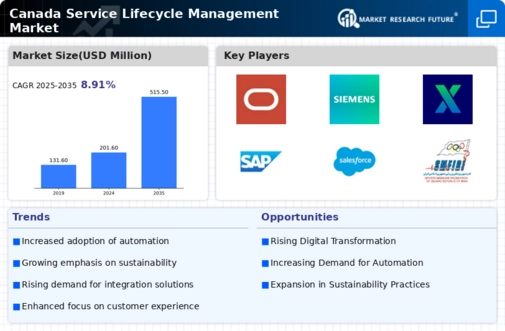The service lifecycle-management market in Canada is characterized by a dynamic competitive landscape, driven by rapid technological advancements and increasing demand for efficient service delivery. Key players such as ServiceNow (US), IBM (US), and SAP (DE) are at the forefront, each adopting distinct strategies to enhance their market positioning. ServiceNow (US) focuses on innovation through its cloud-based solutions, aiming to streamline service management processes. IBM (US), on the other hand, emphasizes digital transformation and AI integration, leveraging its extensive research capabilities to develop cutting-edge solutions. SAP (DE) is strategically positioned to enhance its enterprise resource planning (ERP) offerings, integrating service lifecycle management to provide comprehensive solutions for businesses. Collectively, these strategies contribute to a competitive environment that is increasingly centered around technological innovation and customer-centric solutions.
In terms of business tactics, companies are increasingly localizing their operations to better serve the Canadian market, optimizing supply chains to enhance efficiency. The competitive structure of the market appears moderately fragmented, with several key players exerting influence while also facing competition from emerging firms. This fragmentation allows for a diverse range of solutions, catering to various customer needs and preferences, thereby fostering a competitive yet collaborative atmosphere.
In October 2025, ServiceNow (US) announced a strategic partnership with a leading Canadian telecommunications provider to enhance its service management capabilities. This collaboration is expected to leverage the telecommunications provider's extensive network infrastructure, allowing ServiceNow (US) to offer more robust solutions tailored to the unique needs of Canadian businesses. The strategic importance of this partnership lies in its potential to expand ServiceNow's market reach and enhance its service delivery capabilities in a competitive landscape.
In September 2025, IBM (US) unveiled a new AI-driven analytics platform designed specifically for service lifecycle management. This platform aims to provide businesses with actionable insights to optimize their service delivery processes. The introduction of this platform signifies IBM's commitment to integrating advanced technologies into its offerings, positioning the company as a leader in innovation within the market. The strategic importance of this move is underscored by the growing demand for data-driven decision-making in service management.
In August 2025, SAP (DE) launched an updated version of its service lifecycle management software, incorporating advanced machine learning algorithms to enhance predictive maintenance capabilities. This update is particularly relevant as it aligns with the increasing focus on sustainability and operational efficiency among Canadian businesses. The strategic significance of this enhancement lies in its ability to help organizations reduce downtime and optimize resource utilization, thereby driving cost savings and improving service quality.
As of November 2025, current trends in the service lifecycle-management market are heavily influenced by digitalization, sustainability initiatives, and the integration of AI technologies. Strategic alliances are becoming increasingly vital, as companies seek to combine their strengths to deliver comprehensive solutions. Looking ahead, competitive differentiation is likely to evolve, shifting from traditional price-based competition to a focus on innovation, technological advancements, and supply chain reliability. This transition suggests that companies that prioritize these aspects will be better positioned to thrive in an increasingly competitive landscape.
























Leave a Comment